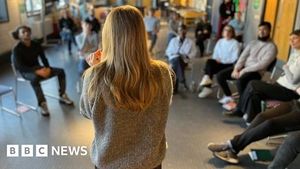As the United Kingdom prepares to open a public inquiry into the effects of the Covid-19 pandemic on children and young people, a new report—seen exclusively by BBC—has brought to light the deeply personal stories of loss, resilience, and transformation among the nation’s youth. Meanwhile, across the Atlantic, debates rage over how best to protect young people from the ongoing threats of nicotine addiction and vaping-related illnesses, as highlighted by NPR’s recent coverage of the Trump administration’s controversial health strategy. Together, these stories reveal a generation marked by crisis, adaptation, and the struggle for recognition in public policy.
In Wigan, 17-year-old Sam stands as a symbol of the pandemic’s profound impact on young lives. When the first lockdowns hit, Sam was just 12, living with his mother after his parents’ separation. The sudden death of his father during the pandemic left him grappling with a sense of loss compounded by the strict rules that kept him apart from his dad in his final days. “I do feel deep down that something has been stolen from me,” Sam told BBC. “But I do know that the procedures that we had to go through were right. It was a bad situation.”
Sam’s journey through grief did not end there. Recently, he lost his mother to cancer, a blow that would test anyone’s resilience. Yet, Sam credits the strength he built during the pandemic with giving him “the tools to deal with grief alone.” His story is echoed by hundreds of other young people whose testimonies form the backbone of the new report, which includes accounts from 600 individuals under 18. Their experiences range from the trauma of bereavement and social isolation to unexpected moments of happiness found in family togetherness and online learning.
Kate Eisenstein, part of the team leading the UK inquiry, describes the pandemic as a “life-changing set of circumstances” for children and teenagers. The testimonies collected reveal a diverse landscape: some young people flourished in secure homes, embracing remote education, while others faced the stark reality of fragile family situations, mental health struggles, and even domestic violence. For many, the loss of parents or grandparents was compounded by the inability to mourn together, with funerals taking place online or under strict distancing rules.
One of Sam’s classmates, Ella, shared with BBC how the loss of her granddad during Covid made her value the time she now spends with her grandma. In her words, she’s “trying to catch up on the lost moments” missed during the pandemic’s darkest days. It’s a sentiment that resonates with countless others who found their formative years interrupted by unprecedented global upheaval.
Perhaps one of the most universal experiences for children during this period was the migration of daily life to online platforms. While digital tools allowed for continued connection with friends and family, they also exposed young people to new risks. Eisenstein notes that some children spent up to 19 hours a day online, leading to increased anxiety and negative self-image. “Some told us how they started comparing their body image to people online, how video games and social media distracted from their learning,” she explained. Even more alarming were reports of adults exploiting children online, sending inappropriate messages and images.
Aaliyah, a student at Winstanley College near Wigan, recounted how social isolation at age 11 led her to spend hours on social media, which began to erode her self-confidence. “With the content I was seeing online, I’d start to look in the mirror and go, ‘I could change that about myself,’ or ‘I don’t really like that about myself,’” she shared. These revelations, Eisenstein says, offer “an unprecedented insight into children’s inner world.”
For some, the pandemic’s effects linger in the form of long Covid. Avalyn, now 16, fell ill in October 2021 and was forced to leave school due to debilitating fatigue. It took a year for her to receive a formal diagnosis and specialist advice. “I enjoyed being in school, I enjoyed being social and seeing people, and then suddenly that was taken away from me very quickly,” Avalyn told BBC. Despite these setbacks, she demonstrated remarkable determination, passing four GCSEs and staying involved with a performing arts group. “I knew I wanted to do GCSEs to prove to myself especially that I still had the ability to do what everyone else was doing,” she said. In a surprising twist, Avalyn described feeling “grateful” for the challenges of long Covid, as they led her to write and self-publish two children’s books and deepen her passion for art.
The UK inquiry, set to run from September 29 to October 23, 2025, aims to shed light on these varied experiences and inform future policy. As Eisenstein puts it, the evidence gathered paints a picture of both “positive and stressful” experiences, underlining the need for a nuanced understanding of what children endured.
Across the ocean, the health of children and teenagers is also at the forefront of public debate, but the focus is different. The Trump administration’s recently released report, “Make Our Children Healthy Again,” has sparked controversy for its omission of key terms like “smoking” and “nicotine,” despite tackling childhood health issues. Frances Daniels, a Baltimore mother whose child suffered a severe vaping-related lung injury known as EVALI, was “horrified” by the absence. “It never once mentioned substance usage. Specifically: nicotine,” she told NPR.
Health Secretary Robert F. Kennedy Jr. insists the strategy is “mobilizing every part of government to confront the childhood chronic disease epidemic.” The report recommends public-service campaigns about the risks of alcohol, controlled substances, and vaping, and touts a recent $86 million seizure of e-cigarettes as evidence of ongoing enforcement. Yet, experts like Brian King, former head of the FDA’s Center for Tobacco Products, argue that omitting tobacco control is a critical flaw. “Something to combat chronic disease without tobacco control is like attempting a triathlon without a bicycle—you are destined for failure before leaving the starting line,” King told NPR.
Critics also point to the administration’s cuts to successful tobacco control efforts, including eliminating the FDA unit responsible for enforcement and the CDC’s Office of Smoking and Health, which funded state programs that have reduced teen smoking and vaping rates. The administration’s withdrawal of plans to ban menthol-flavored cigarettes—products known to attract youth—has drawn further ire from public health advocates. Priya Fielding-Singh, director of policy at the Global Food Institute at George Washington University, stated, “An educational campaign isn’t a compelling substitute for enacting tobacco regulation to keep these products out of the hands of kids and teens.”
Despite these challenges, data show that smoking and vaping are falling out of favor with adolescents. Penn State’s Jonathan Foulds suggests that nicotine, while addictive and harmful to heart health, is not the most pressing public health concern for youth compared to other threats. He notes that newer forms of nicotine use, such as oral pouches and vaping, are “much less harmful than smoking,” though not harmless. “We shouldn’t exaggerate the risk of it; we should be glad that they’re not smoking,” Foulds said. Still, for parents like Daniels, the dangers remain clear: “Nicotine is harmful, as well as the process of vaping—they’re both harmful.”
As inquiries and debates unfold on both sides of the Atlantic, one thing is certain: the voices of young people and their families are finally being heard. Their stories, marked by hardship and hope, are shaping the policies that will define the next generation’s health and well-being.




